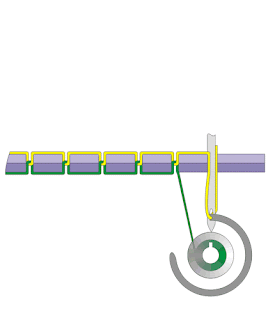How sewing tension works
Tension
I spoke with a Brother engineer who explained to me that often poor output from a machine can often be due to a build up of fluff. New machines, particularly computerised machines, are very sensitive to fluff and dust.
- You need to make sure your tension discs are clear of fluff, a build up from thread pulling through the machine. The safest way to clear them is to use the edge of a lint free cloth, such as the ones provided with your glasses. Or otherwise a pipe cleaner between the discs will do.
To minimise this happening again, use a good thread. I'm not going to endorse any particular to you, but I often find that if you pay a little more, or look for a lower number of twists (I use a 40 twist), I find that I don't have this problem.
- Another non common fault in the tension is due to the bobbin case being loosened over time.
The constant vibrations of the machine shouldn't cause too much problem, but over time, the screw does become a little loose and you'll find your stitches aren't as perfect. You should only need to turn the scree about and eight of the way, a quarter maximum. Any more and your bobbin thread won't feed through. This is done differently on each type of machine and you should check out your manual (or contact me) to see how you can see if yours is correctly set.
- Finally, store your machine covered. I'm quite lazy or forgetful, so I find I'm cleaning my machine more often than I would if I kept them covered, but I am also an "out of sight, out of mind" person. I like my machines out where I can see them.
Skipped Stitches
In this image, you can see that the top stitches are skipped, this may be due to :

Don't be tempted to buy a generic quality walking foot, yes, they can cost significantly less, but you will see that on your finished product. A generic design is made to fit in all types of machines, and as we know machines are extremely sensitive and with the effort you go to for your finished work, it's worth the extra pennies.
- the wrong, or blunt needle.
- the wrong stitch for the fabric (use stretch stitch for stretch fabrics)
- or, in extreme situations: the feed dogs are incorrectly adjusted - flip the switch up and down

- Stretch fabrics and sometimes sewing on the bias will need a walking foot, as will many layers of fabric. The walking foot feeds the top layer of fabric though the foot as the machine sews, at the same rate the feed dogs do, so you'll find this helps.
Don't be tempted to buy a generic quality walking foot, yes, they can cost significantly less, but you will see that on your finished product. A generic design is made to fit in all types of machines, and as we know machines are extremely sensitive and with the effort you go to for your finished work, it's worth the extra pennies.








Comments
Post a Comment